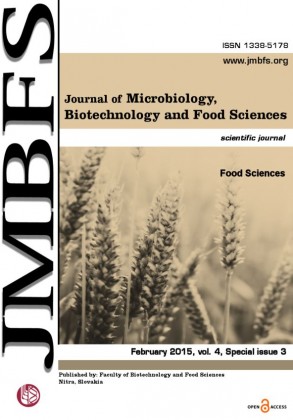IMPACT OF SELECTED PARAMETERS ON MILK PRODUCTION IN TSIGAI BREED
DOI:
https://doi.org/10.15414/jmbfs.2015.4.special3.185-187Keywords:
Sheep, milk yield, milk composition, SCCAbstract
The objective of our research was to study selected parameters which affect milk production. The study was performed in the selected herd of purebred Tsigai ewes (231 animals). Regular milk yield recording was performed during the morning milking in around the middle of April, May and June. Milk samples were analyzed for basic milk composition (fat, protein and lactose) and somatic cells count. According to animals, the dairy ewes were divided into the four groups on the basis of individual SCC (G1= SCC <100×103cells.ml-1, G2= SCC between 100-400×103cells.ml-1, G3= SCC between 400-700×103cells.ml-1, G4= SCC >106 cells.ml-1 to study the frequency of distribution of animals in selected group of ewes throughout experimental period. We have not created group with SCC between 700-1000×103 cells.ml-1 because there would not be sufficient number of animals. The average daily milk production in selected herd of Tsigai was 614.51 ml, equivalent to 95.65 liters for a normalized lactation. We reached the highest daily milk production in April 779 ml and the highest content of fat and protein in May, while milk production was lower by only 30 ml. We conclude that the protein content of milk was over 6% within each division, whether by order of lactation, season or somatic cells count, except of June (5.98%). We found a tendency to lower milk production by a higher SCC. With the increasing SCC decreased lactose content from 4.66% (G1) to 4.27% (G4) and there is a need for performing bacteriological examination in milk.Downloads
Download data is not yet available.
Downloads
Published
2015-02-02
How to Cite
VrÅ¡ková, M., TanÄin, V., Kirchnerová, K., & Sláma, P. (2015). IMPACT OF SELECTED PARAMETERS ON MILK PRODUCTION IN TSIGAI BREED. Journal of Microbiology, Biotechnology and Food Sciences, 4(special issue 3 (Food Sciences), 185–187. https://doi.org/10.15414/jmbfs.2015.4.special3.185-187
Issue
Section
Food Sciences
License
Copyright (c) 2015 Martina VrÅ¡ková, VladimÃÂr TanÄin, KatarÃÂna Kirchnerová, Petr Sláma

This work is licensed under a Creative Commons Attribution 4.0 International License.
All papers published in the Journal of Microbiology, Biotechnology and Food Sciences are published under a CC-BY licence (CC-BY 4.0). Published materials can be shared (copy and redistribute the material in any medium or format) and adapted (remix, transform, and build upon the material for any purpose, even commercially) with specifying the author(s).





